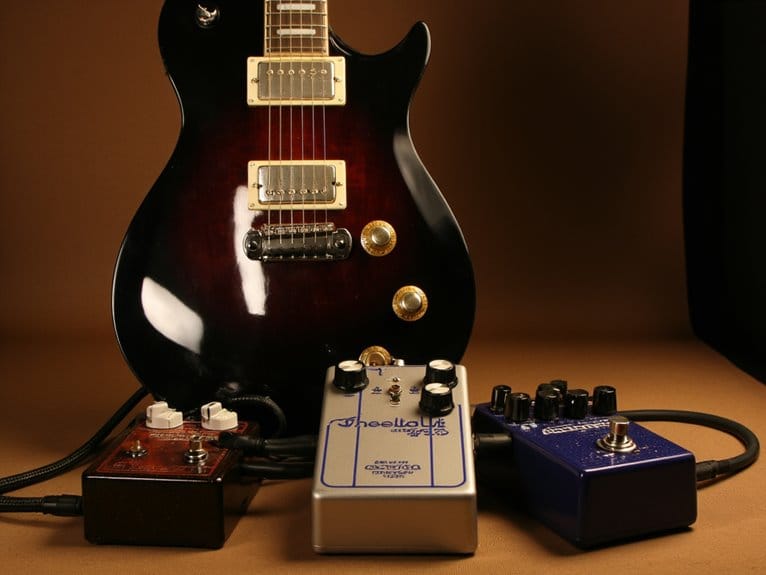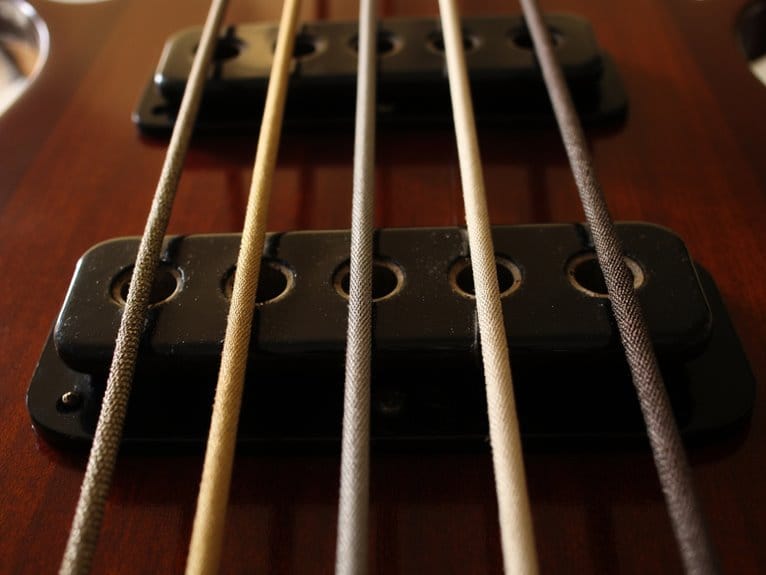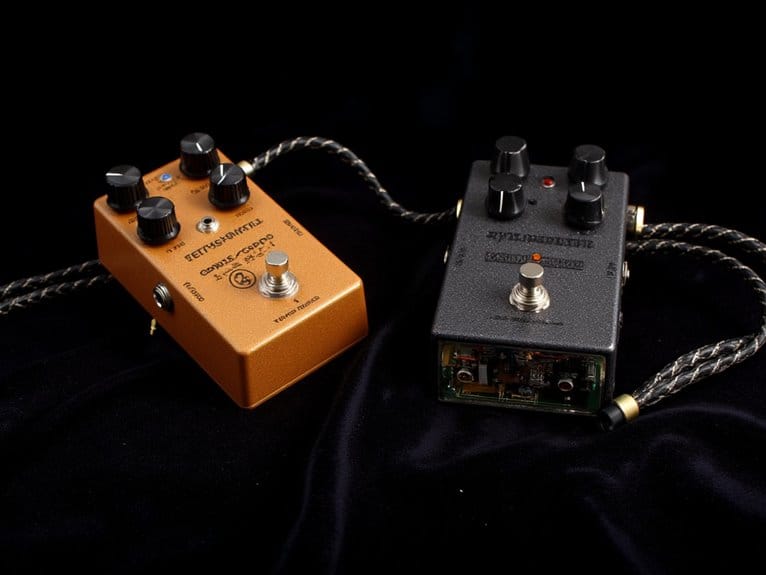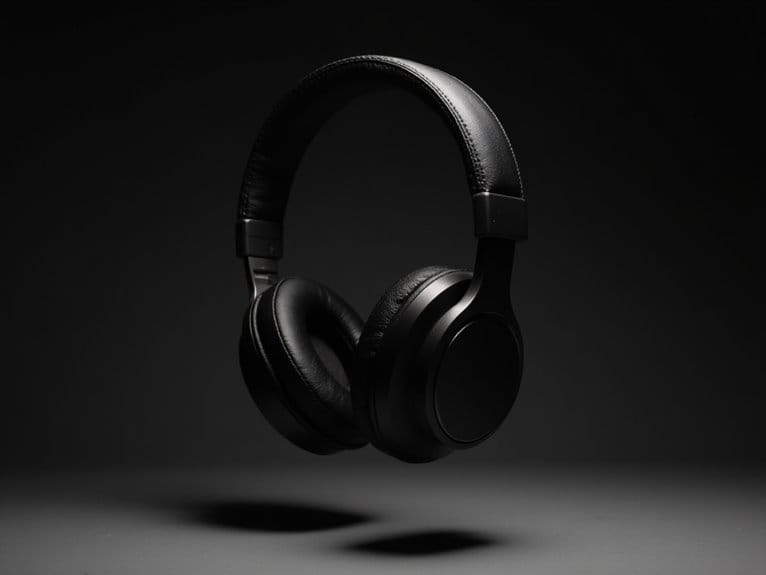Modulation Effects: Chorus, Flanger, and Phaser Applications
You’ll encounter three distinct modulation effects that shape your sound in unique ways: chorus uses 15-35ms delays to simulate multiple performers and create lush thickness, flanger employs shorter sub-10ms delays with feedback for metallic sweeps through comb-filtering, and phaser utilizes all-pass filters to generate smooth whooshing sounds with fewer frequency notches. Each effect processes your signal differently, from chorus’s pitch modulation to flanger’s aggressive character, while essential controls like rate, depth, and feedback determine the intensity and texture of your sonic transformation across various instruments and genres.
We are supported by our audience. When you purchase through links on our site, we may earn an affiliate commission, at no extra cost for you. Learn more.
Notable Insights
- Chorus uses 15-35ms delays to simulate multiple performers, creating thick, lush textures ideal for clean guitar tones and vocal enhancement.
- Flanger employs shorter delays under 10ms with feedback to produce metallic sweeps and comb-filtering effects for aggressive sonic character.
- Phaser utilizes all-pass filters instead of delays, generating smooth whooshing sounds with fewer frequency notches for ethereal movement.
- Rate and depth controls determine modulation intensity, while feedback levels add resonant character and mix balance blends dry/wet signals.
- These effects work across guitars, vocals, bass, and synthesizers, with stacking possibilities creating unique sound design opportunities in production.
Understanding the Core Characteristics of Each Effect
When I first started exploring modulation effects years ago, I’ll admit I was completely confused by the subtle differences between chorus, flanger, and phaser-they all seemed to create some variation of that swirling, movement-based sound that makes instruments feel more alive and dimensional.
Understanding each effect’s core characteristics requires recognizing their distinct approaches to signal processing.
Chorus nuances emerge from longer delay times (15-35ms) that simulate multiple performers, creating thickness without harsh artifacts.
Flanger dynamics utilize shorter delays under 10ms with feedback, producing aggressive metallic sweeps through pronounced comb-filtering. These effects commonly produce classic jet-plane effects and space sound effects that can dramatically transform your sound across various musical genres.
Phaser subtleties rely on all-pass filters shifting phase relationships directly, generating smoother whooshing sounds with fewer frequency notches.
Modulation depth controls how dramatically each LFO affects the underlying signal, ultimately determining whether you’ll achieve gentle enhancement or dramatic transformation.
Similarly, compression pedals enhance guitar tone by smoothing dynamics and ensuring clarity while preserving the natural sound, providing additional sustain and definition through true bypass circuitry that maintains signal integrity.
Technical Differences and Signal Processing Methods
Although these modulation effects might sound similar to untrained ears, their underlying signal processing methods reveal dramatically different approaches to creating movement and space in audio.
When you’re working with these effects, understanding their technical foundations helps you choose the right tool for each musical situation.
The key signal processing differences include:
- Delay times: Chorus uses longer delays (>15ms) for thickening, while flanger employs shorter delays (
- Modulation techniques: Phaser relies on all-pass filters without delay, creating phase shifts that produce sweeping notches.
- Signal processing: Each effect splits your signal differently, with chorus adding pitch modulation and flanger creating comb filtering.
- Feedback control: Higher feedback intensifies each effect’s character, from chorus shimmer to flanger resonance to phaser swirling.
Creative Applications Across Instruments and Genres
Once you’ve grasped the technical foundations of chorus, flanger, and phaser effects, you’ll discover that their creative applications span virtually every instrument and musical genre, each offering distinct sonic possibilities that can transform your recordings from ordinary to extraordinary.
For guitar work, I’ve found that chorus delivers warm, lush textures perfect for clean tones, while flanger creates aggressive, metallic sweeps ideal for psychedelic tonal exploration. Phaser adds subtle movement without overwhelming your original signal, making it excellent for funk applications.
Your vocal tracks benefit markedly from chorus thickening, creating the illusion of multiple singers, whereas flanger and phaser introduce robotic textures and ethereal movement respectively.
Complex effect combinations, like stacking chorus into flanger, open new sound design territories across synthesizers and bass instruments.
Essential Controls and Parameter Settings
While creative applications showcase modulation effects’ artistic potential, mastering their essential controls transforms these tools from mysterious black boxes into precise instruments that’ll serve your musical vision with surgical accuracy.
Understanding control parameters becomes straightforward once you grasp each element’s sonic impact:
Once you understand how each parameter affects your sound, modulation controls become intuitive tools rather than confusing knobs.
- Rate/Speed – Your modulation’s heartbeat, determining whether you’ll achieve gentle warmth or dramatic metallic sweeps.
- Modulation depth – Controls how far your signal travels from its center point, directly affecting texture richness.
- Feedback levels – Adds resonant character but requires careful management to prevent harsh self-oscillation.
- Mix balance – Blends dry and wet signals for subtle enhancement or bold statement effects.
LFO waveforms shape your modulation’s character, while stereo phase settings create spatial width that’ll make your tracks breathe with dimensional movement.
Historical Context and Modern Production Techniques
When I first discovered that flanging originated from physically pressing fingers against tape reels in 1960s studios, it changed how I understood these effects-what we now take for granted as simple plugin parameters once required engineers to literally manipulate spinning tape machines in real-time.
This tape manipulation birthed the psychedelic sounds that defined an era, with artists like Pink Floyd pioneering phaser effects before Hendrix popularized the Uni-Vibe in 1968.
The modulation evolution from analog hardware to digital plugins represents decades of technological advancement, transforming studio-exclusive techniques into accessible tools.
Today’s DAW implementations offer precise parameter control, MIDI synchronization, and stereo widening capabilities that surpass their analog predecessors, while algorithms faithfully recreate those classic tape-based textures we still chase.
On a final note
You’ve now got the essential knowledge to transform your sound using chorus, flanger, and phaser effects. Whether you’re adding subtle shimmer to clean guitars, creating dramatic swooshes in electronic music, or thickening vocal tracks, these modulation tools offer endless creative possibilities. Start with conservative settings, experiment with parameter combinations, and don’t hesitate to automate movements for dynamic interest. Your productions will benefit from understanding these classic effects.







